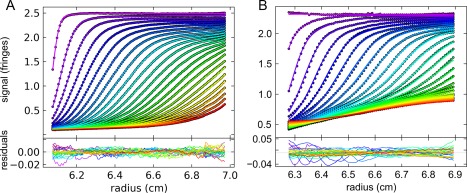Figure 5.

Use of the Buffer Mismatch Model (BMM) in Sedfit allows for correction of nonoptimal sedimentation velocity conditions. (A) A typical c(s) interference data set from a Brpt1.5 experiment in metal‐free MOPS buffer. Circles show every 10th data point of every 3rd scan from the first half of the loaded data set, superimposed by lines showing the modeled fit. (B) The same selection of data from the Brpt5.5 sample with 4 mM CuSO4 is an example of a case where the BMM rescues a condition that would not be accessible using traditional c(s) methods. Note the distinct differences in the shape of the boundaries and the abnormal baseline caused by co‐sedimentation of the Cu2+ ions and mismatch with the buffer blank in the reference sector.
